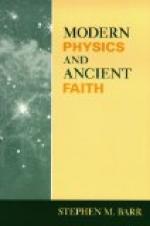The second condition or state of matter is not revealed by either of our five senses, but by the sixth sense, or intuition of man. This is the ether—supposed to be “matter in a very rarefied form, which permeates all space.” So rare and fine is this matter that it interpenetrates carbon or steel as water interpenetrates a sponge, or ink a blotting pad. In fact, each atom of “physical” matter—by which is meant matter in the first condition—floats in an atmosphere of ether as the solid earth floats in its atmosphere of air.
“No two physical atoms touch,” said Faraday. “Each physical atom is the centre of an etheric molecule, and as far apart from every other atom as the stars in heaven from one another.” This is true of every form of physical matter, whether it is a lump of metal, a cup of liquid, or a flask of gas; whether it is a bronze statue or a living man; a leaf, a cloud, or the earth itself. Each and every physical atom is the centre of an etheric molecule made up of many atoms of the ether.
This duality of matter was a wonderful discovery, revolutionizing every department of science. It placed man in actual touch with the whole visible universe. The ether in a man’s eye (and in his whole body) reaches in one unbroken line—like a telegraph wire —from him to the sun, or the outermost planet. He is not separate and apart from “space,” but a part of it. Each physical atom of his physical body is the centre of an etheric molecule, and he has two bodies, as St. Paul said, a visible physical and an invisible etheric body; the latter in actual touch with the whole universe.
Faraday went one step further. He demonstrated that all physical phenomena come from the chording vibration of the physical atom with the surrounding etheric atoms, and that the latter exercise the impelling force on the former. Step into the sunshine. The line of ether from the sun is vibrating faster than the ether in the body, but the higher impels the lower, the greater controls the lesser, and soon both ethers are in unison. The physical atoms must coincide in vibration with their etheric envelopes, and the “note” is “heat.” Step into the shade, where the ocean of ether is vibrating more slowly, and the ether of the body reduces its vibration. “The ether is the origin of all force and of all phenomena.”
This etheric matter follows identical laws with prakritic matter, or, accurately, the laws of our matter flow from the etheric matter from which it is made. The ether has two hundred or more elementary substances, each atom of our eighty or ninety “elements” being the chemical union of great masses of two or more of the etheric elements or their combinations. These etheric elementary substances combine and unite; our elementary substances simply following in their combinations the law which they inherit from their parents. They take form and shape. They vibrate through one octave, and take solid liquid or gaseous form in ether, as their types here in our world take it in prakriti, as their vibrations are increased or diminished. In short, the ether is the prototype of our physical or prakritic world, out of which it is made and a product of which it is.




